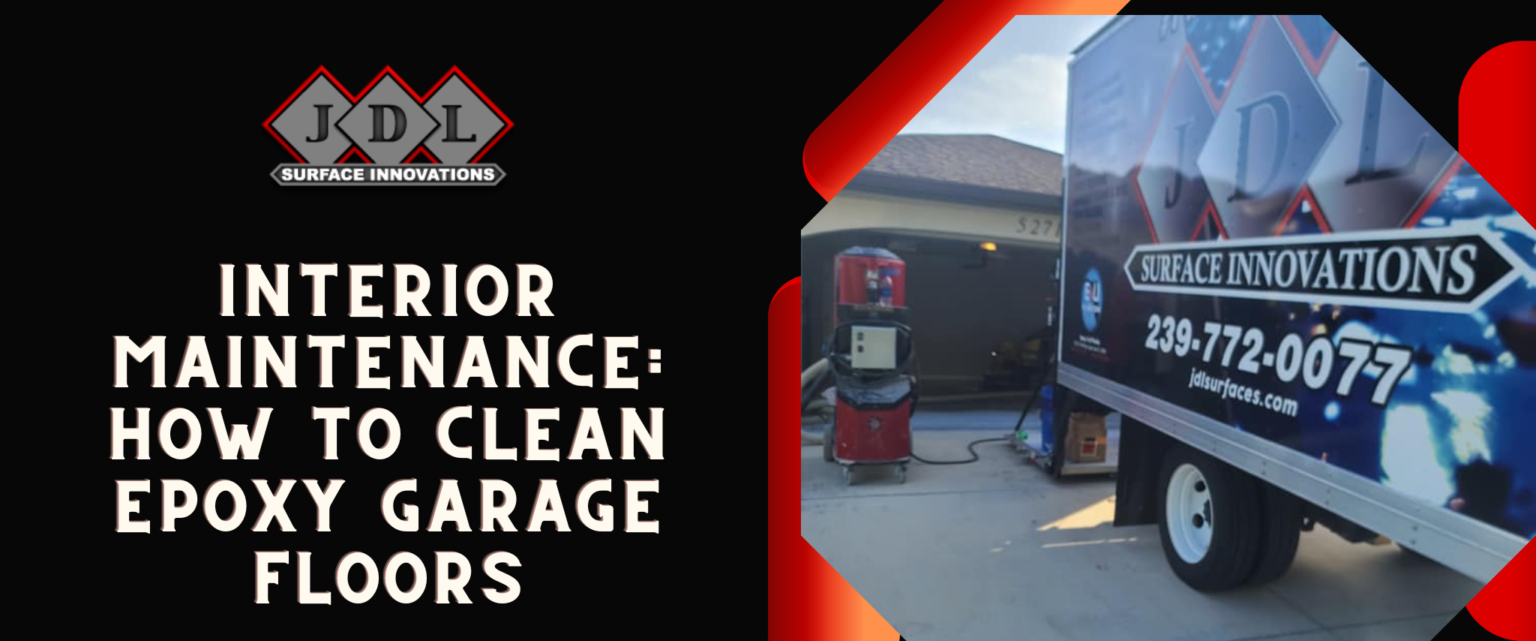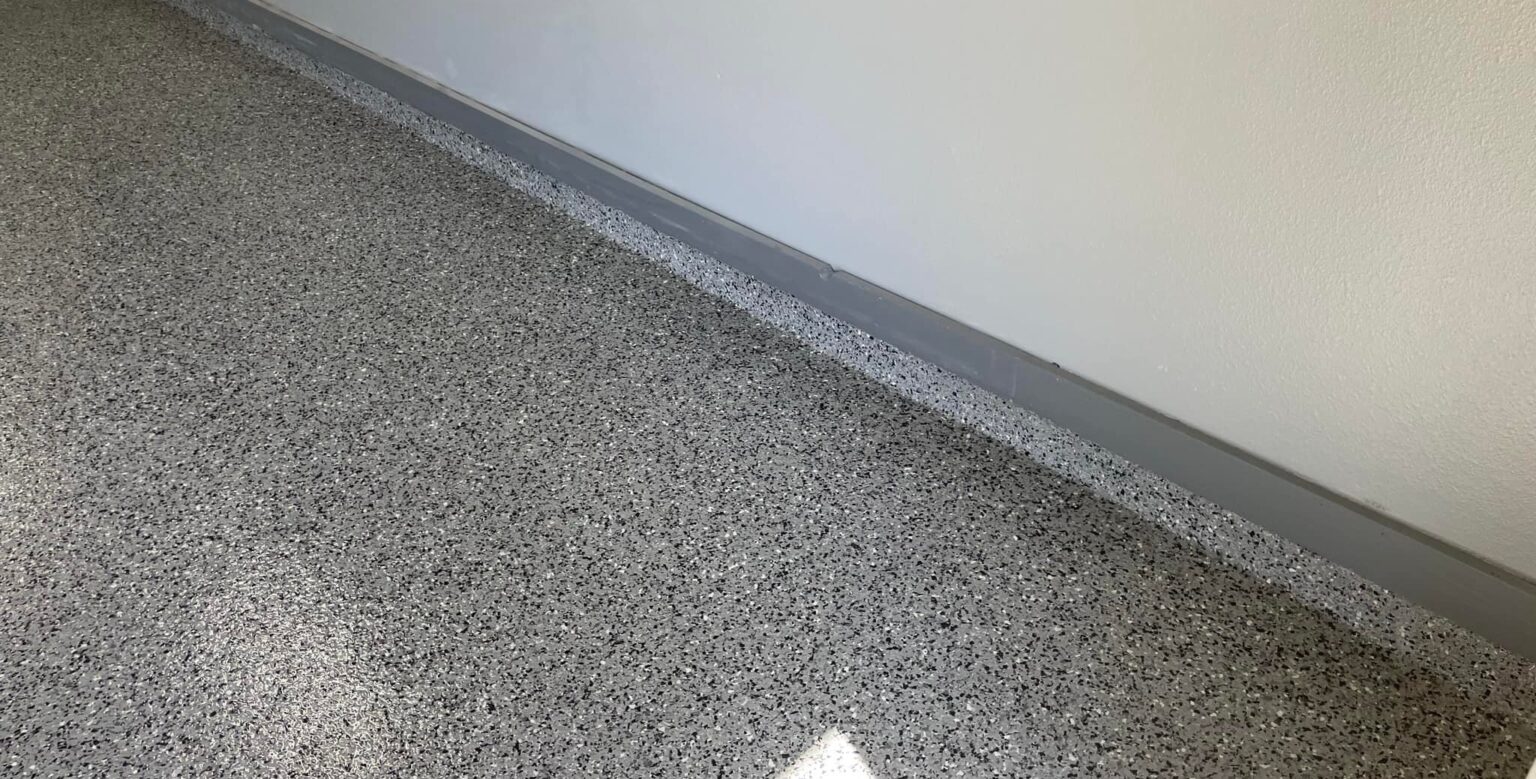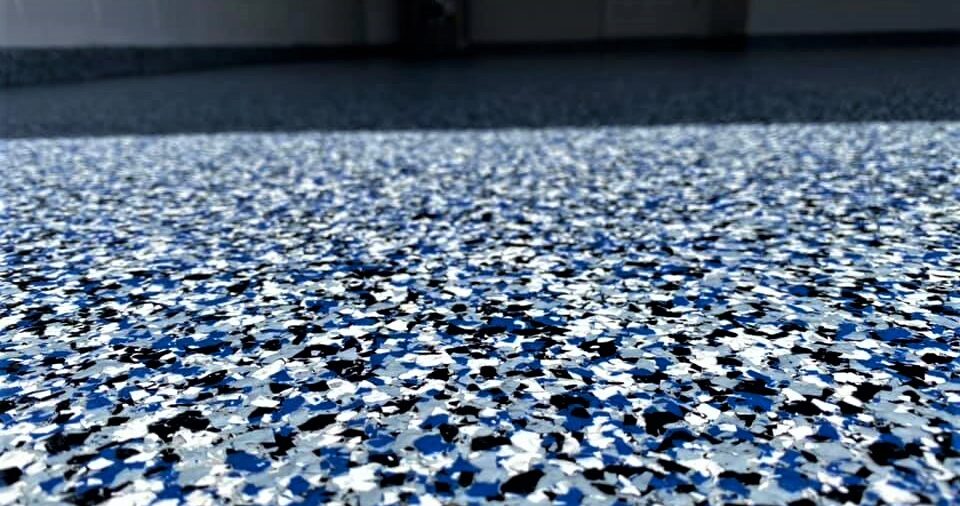Epoxy floors are known for their strength, durability, and stain resistance. If you’ve recently had an epoxy floor coating applied to your garage or are considering investing in an epoxy garage floor, it’s important to know how to clean it.
Fortunately, as long as you have the right materials and cleaning solution, cleaning the floor isn’t much more detailed than cleaning any other surface of your home or business. Here’s a step-by-step guide on how to clean an epoxy floor.
Jump To Section
What You’ll Need
- Microfiber or hard foam mop
- Foam squeegee
- Stiff-bristle nylon brush
- Water
- Bucket
- Broom or vacuum cleaner
- Non-toxic, biodegradable cleaner (Simple Green) or ammonia
- Spray bottle
- Concrete degreaser (optional for tire mark removal)
- CLR (optional, for rust stain removal)

Step 1: Use a Vaccum or Broom to Remove Grit and Dirt
Grit and dirt can easily scratch your epoxy flooring. If it’s scratched or scuffed, the epoxy won’t be waterproof. When left on the surface, the dirt and grit will grind around the floor and scratch it. If you’re moving vehicles onto and off the garage floors or using heavy equipment a lot, the dirt is more likely to scratch.
Sweep the floor with a broom, or vacuum the floor with a soft brush attachment to remove all the surface dirt from the floor. Do not wash or scrub an epoxy floor while dirt particles are present, as you can damage the floor.
Step 2: Mop
Next, remove any caked-on dirt with a microfiber mop and some warm water. Wring out the mop often to get rid of dirt without scratching the floor. If your floor also has an anti-slip aggregate coating, use a soft bristle broom. Remove any residue with the squeegee.
Step 3: Remove Any Stubborn Residual Dirt
Most of the time, mopping your epoxy garage floor will get it clean. But, if any large dirt deposits just won’t loosen up with warm water, you’ll need to attack those with a squeegee or a soft-bristled brush. If possible, avoid using a metal frame squeegee. If there’s no other option, make sure it has rounded corners. Otherwise, you may damage the floor. Avoid scrapers with metal blades, as these, too, can damage the finish.
Step 4: Make Your Cleaning Solution
For tougher stains, mix one gallon of hot water with 1/2 cup of Simple Green. Ensure the solution isn’t overly concentrated because it can leave a thin film on the floor. Both ammonia and Simple Green are safe for your floor, but it’s best to use ammonia unless you’re dealing with stains and scratches.
Pour the mixture into a spray bottle or a bucket.
Cleaning Solutions to Avoid on Epoxy Floor Coatings!
Not just any cleaner will work on an epoxy floor finish. Soap-based floor cleaners will damage epoxy floors. You should also avoid citrus cleaners or vinegar, as the acid can break down the epoxy finish and damage the floor surface. Do not use bleach.
Step 5: Use the Cleaning Solution on the Epoxy Floors
Spray the cleaner on your floor generously, covering the entire surface. Alternatively, mop the floor directly from a bucket full of the solution. Submerge the mop and wring it out, then clean the floor.
If you’d rather scrub the floor, spray the solution onto the floor, then scrub with a stiff-bristle nylon brush.
Let the floor air dry, or wipe it using a clean microfiber shop towel or soft dust mop.
Step 6: Use Concrete Degreaser to Remove Tire Marks (As Needed)

If your epoxy garage floor has tire marks, saturate those areas with a concrete degreaser. Allow the degreaser to soak into the floor for about 10 minutes. Scrub the marks with a stiff-bristled nylon brush. If the marks are still present, repeat.
Once the tire marks are gone, rinse the area with water and towel dry.
Step 7: Use a Cleaning Solution to Remove Rust Stains (As Needed)
If you have rust stains, use a kitchen sponge or soft deck brush to scrub the stains away with warm water. For heavier stains, mix one part warm water with one part CLR. Spray it on the surface and scrub with a soft brush. Rinse with cold water. Towel dry after two minutes.
Do not use anything abrasive like steel wool to help remove rust or other stubborn stains. The abrasive material will scratch the floor and damage the surface.
Step 8: Rinse and Dry the Floor
Once the floor is clean, rinse it to remove residual cleaners and water. Don’t leave your floor wet. Not only is it slippery and a fall hazard, but it can lead to mold and mildew growth.
Rinse your mop with clean water. Wring it out and then clean up any excess water. Allow the floor to dry before walking on it.
Ready For A State of The Art Floor?
Epoxy Floor Cleaning Tips
A dirty epoxy floor is bound to happen, even with regular maintenance. If you want to avoid frequent, time-consuming deep cleaning, use these tips to help keep the entire floor looking great between washes.
Take Care of Spills Quickly
If you spill something, clean it up as soon as possible. If chemicals like brake fluid, oil, gasoline, or antifreeze get on the floor, do not leave them any longer than necessary.
These chemicals can not only lead to things like headaches, allergic reactions, and respiratory issues, but they can also stain your epoxy floors. Chemicals may do more than discolor the flooring – they can also weaken epoxy floor coatings.
If you have a spill, apply the appropriate neutralizing agent. This will prevent any reaction from mixing the chemicals with water. Use shop cloths or a squeegee to remove any excess liquid.
Protect Your Floor from Damage
Spills happen, but prevention is key. Whenever possible, use mats or plywood to protect your floor if you are doing an oil change. Whenever there’s a heavy load like cars or heavy machinery, keep the area free of dirt and debris that scratch the floor.
If you notice the surface start to lose its sheen, apply a high-quality wax. It’ll help keep the floor shiny but also help protect the surface. The higher traffic the area, the more wax you’ll need.
Spot Clean When Needed
To save time, you don’t need to clean the entire floor every day. Instead, you can spot clean the areas that need attention. When dealing with a small space with dry dirt, sweep or vacuum with your shop vac. If you have spilled liquid, remove solid debris and dirt before starting to spot clean with a degreaser. Once everything is cleaned up, mop the area with warm water. Then, dry it with a shop towel.
Cleaning Epoxy Garage Floors is Essential for a Long Lifespan
Just because your garage epoxy floor coating is durable doesn’t mean you can let it take a beating every day. The better you take care of it, the longer it will last. Taking care of it means regular cleaning and periodic waxing. Florida gets really hot in the summer so hot tires can make issues on epoxy floors that are not applied correctly.
Need help with your epoxy garage floors? Contact us today to find out more.



















